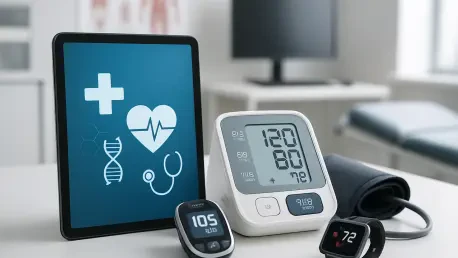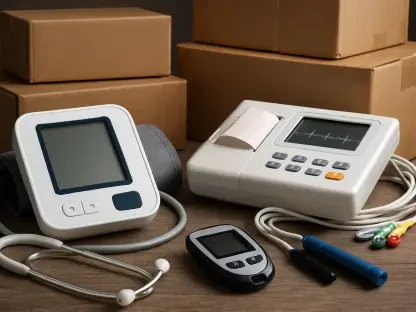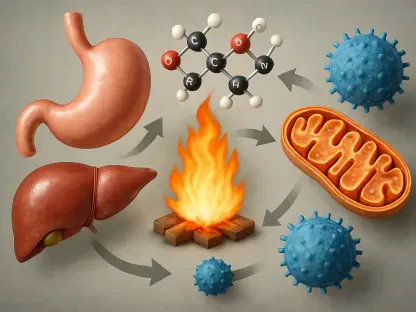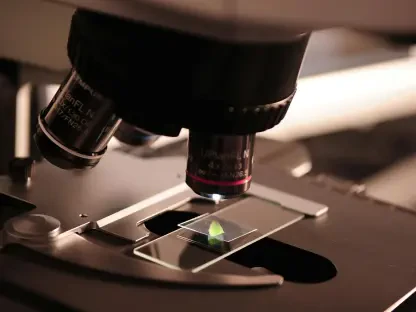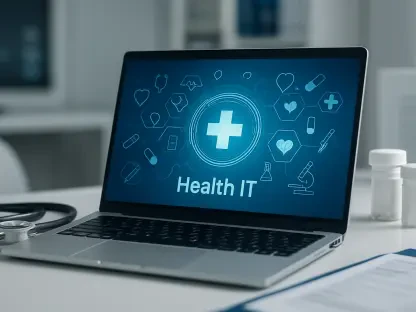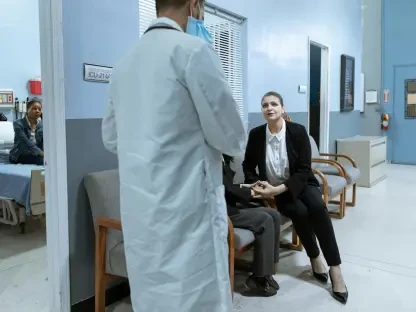In the heart of underserved communities, where access to quality healthcare often feels like a distant dream, health technology is emerging as a beacon of hope, transforming lives in profound ways by bringing innovative solutions to those who need them most. Consider a place like Camden, New Jersey, a city of roughly 70,000 residents near Philadelphia, where life expectancy can differ by as much as 16 years between neighboring areas, and chronic conditions such as hypertension and type 2 diabetes disproportionately burden the population. For too long, systemic barriers like limited transportation, scarce medical facilities, and deep-seated distrust in healthcare systems have left many without the care they desperately need. Yet, innovative programs powered by cutting-edge tech are rewriting this narrative. Initiatives like the Healthy Neighbor program, a collaboration between Medtronic LABS and Virtua Health, are proving that technology, when paired with human connection, can bridge gaps in health equity. By bringing care directly into homes and addressing both medical and social needs, health tech is turning challenges into opportunities, offering a glimpse of a healthier future for those often overlooked.
Redefining Access Through Community-Driven Solutions
In underserved regions like Camden, the struggle to access healthcare isn’t just about distance—it’s about systemic obstacles that have persisted for generations, from inadequate public transportation to a shortage of nearby clinics. Health technology steps in as a game-changer through programs like Healthy Neighbor, which deploys community health workers to deliver care right at patients’ doorsteps. This approach targets individuals grappling with chronic illnesses such as high blood pressure and diabetes, ensuring they receive consistent, personalized attention without the burden of navigating a complex system. By focusing on health equity, the initiative doesn’t merely treat symptoms; it tackles root causes like poverty and isolation that exacerbate poor health outcomes. The result is a model that makes medical support not just available but truly accessible, breaking down barriers that have long kept vulnerable populations from getting the help they need.
Beyond physical access, health tech addresses the cultural and social dimensions of care in underserved areas. Community health workers, often locals themselves, bring an understanding of the unique challenges their neighbors face, fostering a level of comfort that traditional healthcare settings often lack. These workers assist with more than just medical needs—they help secure stable housing, connect families to food resources, and provide emotional support during tough times. Technology amplifies their efforts by streamlining logistics, allowing them to focus on building relationships rather than getting bogged down by administrative tasks. This blend of personal engagement and digital efficiency transforms the healthcare experience, turning what was once a source of frustration into a lifeline for many residents. It’s a reminder that solving disparities requires meeting people where they are, both literally and figuratively, with solutions tailored to their realities.
Building Trust with a Human Touch
One of the most powerful ways health technology impacts underserved communities is by rebuilding trust in a system that has historically failed many. In places like Camden, past experiences of neglect or dismissive treatment have left deep scars, making individuals hesitant to seek help. Community health workers, central to initiatives like Healthy Neighbor, act as trusted advocates, visiting homes and forming genuine bonds with patients. Their role goes far beyond dispensing medication or taking vitals; they listen to concerns, celebrate small victories, and stand by patients through setbacks. This consistent, compassionate presence helps dismantle long-held skepticism, showing residents that someone truly cares about their well-being. Health tech supports these connections by ensuring workers have the tools to stay engaged, proving that innovation can amplify humanity rather than replace it.
The impact of trust-building extends into measurable health improvements that might otherwise remain out of reach. When patients feel valued, they’re more likely to follow treatment plans, attend follow-up appointments, and openly share struggles that could affect their care. In underserved areas, where social determinants like stress or food insecurity often compound medical issues, this openness is critical. Technology plays a subtle but vital role here, enabling workers to track progress and spot warning signs early, all while maintaining focus on personal interaction. Stories from Camden reveal how such relationships have turned lives around—patients who once avoided doctors now welcome support, thanks to workers who treat them as individuals, not case numbers. This synergy of empathy and tech highlights a fundamental truth: lasting change in healthcare starts with restoring faith in the system, one person at a time.
Amplifying Impact with Digital Innovation
Health technology’s ability to enhance care delivery in underserved communities is vividly demonstrated through tools like the SPICE platform, developed by Medtronic LABS. This digital solution equips community health workers with the means to monitor critical health metrics such as blood pressure and glucose levels in real time, flagging urgent issues for immediate action. By automating data collection and reducing administrative burdens, it frees up time for workers to engage directly with patients, addressing their unique needs with greater focus. In a city like Camden, where resources are often stretched thin, such efficiency is invaluable, ensuring that limited staff can serve more people without sacrificing quality. The platform also connects local efforts to larger health systems, creating a seamless network that prevents anyone from falling through the cracks.
Moreover, the integration of technology in community care brings a level of precision that was previously unattainable in many underserved settings. Alerts for abnormal readings mean interventions happen swiftly, often averting crises before they escalate. This proactive approach is especially crucial for chronic conditions like diabetes, where small changes can have outsized consequences if ignored. Beyond emergencies, the data gathered helps tailor long-term care plans to each patient’s trends, making treatments more effective. In regions where access to specialists or hospitals is limited, this capability acts as a lifeline, bridging the gap between immediate needs and comprehensive care. Health tech, in this context, isn’t just a tool—it’s a catalyst that empowers workers to deliver hospital-level attention in the comfort of a patient’s home, redefining what’s possible for health equity.
Measuring Success and Scaling Solutions
The transformative power of health technology shines through in the tangible outcomes seen in programs like Healthy Neighbor in Camden. Over a span of two years, an impressive 74% of patients with uncontrolled hypertension and 69% of those with unmanaged diabetes achieved better control of their conditions. These figures translate to real-world impact—fewer hospital visits, reduced complications, and an improved quality of life for individuals who once felt powerless over their health. Such results underscore how combining tech with community outreach can address chronic issues that traditional systems have struggled to manage. Each percentage point represents a person whose daily struggles have eased, a family relieved of worry, and a community inching closer to equity in health outcomes, proving that targeted innovation can yield profound change.
Looking ahead, the success in Camden is sparking broader momentum for health tech in underserved areas. With a grant secured from the city, the Healthy Neighbor program is expanding to reach more residents, demonstrating local commitment to scaling what works. Even more promising is the development of a toolkit designed to help other health systems across the country replicate this model. This blueprint offers hope that the benefits seen in one city can spread nationwide, addressing disparities in countless other communities facing similar challenges. Health technology, as evidenced by these efforts, isn’t a temporary fix but a foundation for systemic reform. As more regions adopt these strategies, the potential grows for a future where no one is left behind, regardless of zip code or circumstance, marking a significant step toward a more just healthcare landscape.
Reflecting on a Path Forward
Looking back, the journey of health technology in underserved areas like Camden reveals a potent blend of innovation and empathy that has reshaped countless lives. Programs like Healthy Neighbor demonstrate that even in the face of deep-rooted disparities, targeted solutions can yield remarkable improvements, with significant percentages of patients regaining control over chronic conditions. The dedication of community health workers, supported by tools like the SPICE platform, rebuilds trust where it had been eroded, while data-driven results provide undeniable evidence of impact. As this model gains traction, its expansion within Camden and the creation of a replication toolkit mark a pivotal moment in the fight for health equity. Moving forward, stakeholders must prioritize funding and policy support to scale these initiatives, ensuring that technology continues to serve as a bridge to better health for all. Collaboration between tech developers, local leaders, and healthcare providers will be key to sustaining this momentum, offering a roadmap for lasting change.
